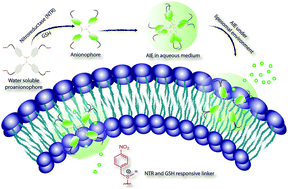Stimuli-responsive transmembrane anion transport by AIE-active fluorescent probes†
Abstract
Anticancer drug resistance implicates multifunctional mechanisms, and hypoxia is one of the key factors in therapeutic resistance. Hypoxia-specific therapy is considered an extremely effective strategy to fight against cancer. The development of small molecule-based synthetic anion transporters has also recently drawn attention for their potential therapeutic applications against several ion-transport-associated diseases, such as cancer and others. Herein, we describe the development of a hypoxia-responsive proanionophore to trigger controlled transport of anions across membranes under pathogenic conditions. Herein, we report the development of tetraphenylethene (TPE)-based anion transporters. The sulfonium-linked p-nitrobenzyl containing TPE-based proanionophore could be converted into a lipophilic fluorescent Cl− ion carrier in a hypoxic or reductive environment. Stimuli such as nitroreductase (NTR) and glutathione (GSH) mediated regeneration of the TPE-based active Cl− ion transporter also showed aggregation-induced emission (AIE) properties. We hypothesize that such hypoxia and reductive stimuli activatable proanionophores have tremendous potential to fight against channelopathies, including cancer.

- This article is part of the themed collection: Supramolecular chemistry in OBC


 Please wait while we load your content...
Please wait while we load your content...